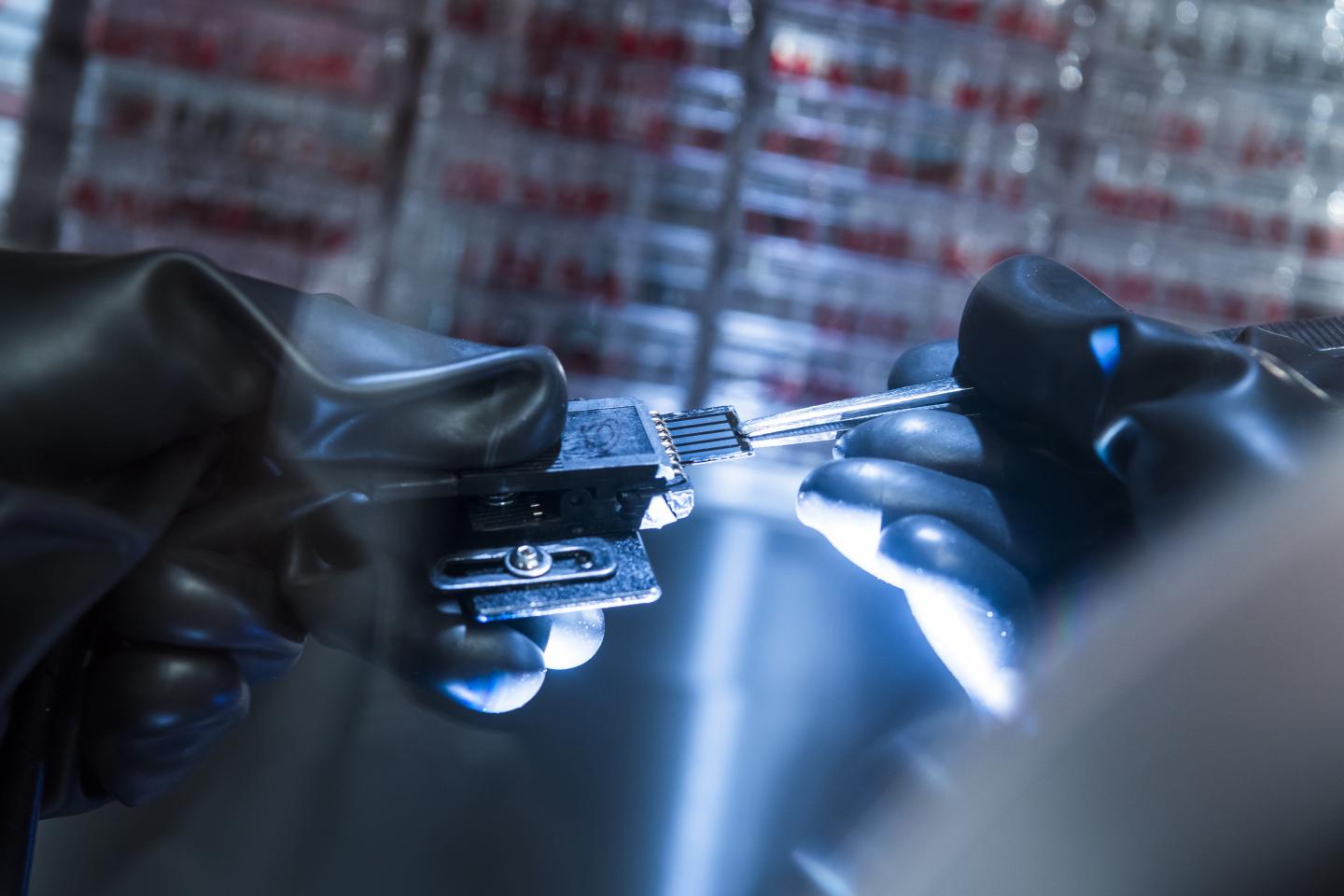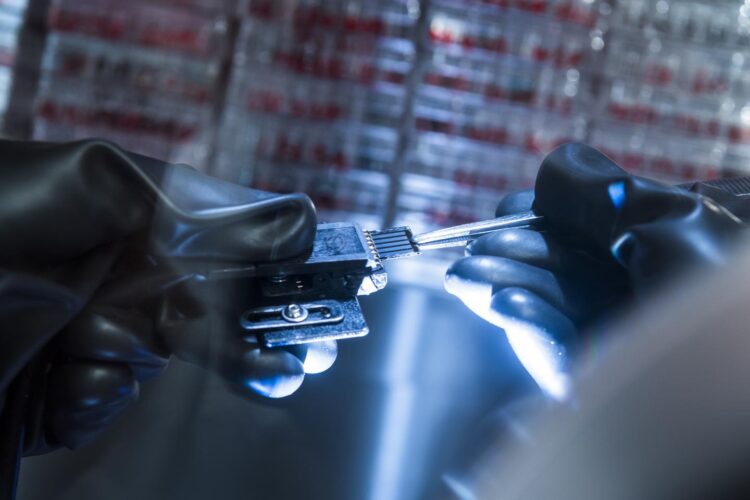
Credit: City University of Hong Kong
While the power conversion efficiency of perovskite solar cells (PVSCs) – a future of solar cells – has already greatly improved in the past decade, the problems of instability and potential environmental impact are yet to be overcome. Recently, scientists from City University of Hong Kong (CityU) have developed a novel method which can simultaneously tackle the leakage of lead from PVSCs and the stability issue without compromising efficiency, paving the way for real-life application of perovskite photovoltaic technology.
The research team is co-led by Professor Alex Jen Kwan-yue, CityU’s Provost and Chair Professor of Chemistry and Materials Science, together with Professor Xu Zhengtao and Dr Zhu Zonglong from the Department of Chemistry. Their research findings were recently published in the scientific journal Nature Nanotechnology, titled “2D metal-organic framework for stable perovskite solar cells with minimized lead leakage“.
Currently, the highest power conversion efficiency of PVSCs has been on par with the state-of-the-art silicon-based solar cells. However, the perovskites used contain lead component which raises a concern for potential environmental contamination. “As the solar cell ages, the lead species can leak through the devices, e.g. through rainwater into the soil, posing a toxicity threat to the environment,” explained Professor Jen who is an expert in PVSCs. “To put PVSCs into large-scale commercial uses, it requires not only high power conversion efficiency but also long-term device stability and minimised environmental impact.”
Collaborating with Professor Xu whose expertise is materials synthesis, Professor Jen and Dr Zhu led the team to overcome the above challenges by applying two-dimensional (2D) metal-organic frameworks (MOFs) to PVSCs. “We are the first team to fabricate PVSC devices with minimised lead leakage, good long-term stability and high power conversion efficiency simultaneously,” Professor Jen summarised their research breakthrough.
Multi-functional MOF layer
Metal-organic framework (MOF) materials have been previously applied as scaffolds to template the growth of perovskites. Scientists have also used them as additives or surface modifiers to passivate (to reduce the reactivity of the material’s surface) the defects of perovskites for enhancing the device performance and stability.
However, most of the 3D MOFs are quite electrical insulating with low charge-carrier mobility, hence unsuitable to be used as the charge-transporting materials.
But the MOFs prepared by Professor Xu is different. They are honeycomb-like, 2D structure equipped with numerous thiol groups as a key functionality. They possess suitable energy levels, enabling them to be an electron-extraction layer (also called “electron-collection layer”) where electrons are finally collected by the electrode of the PVSCs. “Our molecular engineered MOFs possess the property of a multi-functional semiconductor, and can be used to enhance the charge extraction efficiency,” explained Professor Xu.
Trapping the lead ions to prevent contamination
More importantly, the dense arrays of thiol and disulphide groups in the MOFs can “capture” heavy metal ions at the perovskite-electrode interface to mitigate lead leakage.
“Our experiments showed that the MOF used as the outer layer of the PVSC device captured over 80% of the leaked lead ions from the degraded perovskite and formed water-insoluble complexes which would not contaminate the soil,” Professor Jen explained. Unlike the physical encapsulation methods used in reducing lead leakage in other studies, this in-situ chemical sorption of lead by the integrated MOF component in the device was found to be more effective and sustainable for long-term practical applications.
Long-term operational stability achieved
Moreover, this MOF material could protect perovskites against moisture and oxygen while maintaining high efficiency.
The power conversion efficiency of their PVSC device modified with MOF could reach 22.02% with a fill factor of 81.28% and open-circuit voltage of 1.20 V. Both the conversion efficiency and the open-circuit voltage recorded are among the highest values reported for the planar inverted PVSCs. At the same time, the device exhibited superior stability in an ambient environment with the relative humidity of 75%, maintaining 90% of its initial efficiency after 1,100 hours. In contrast, the power conversion efficiency of the PVSC without MOF dropped significantly to less than 50% of its original value.
Also, their device retained 92% of its initial efficiency under continuous light irradiation for 1,000 hours at 85°C. “Such level of stability has already met the standard for commercialisation set by the International Electrotechnical Commission (IEC),” said Dr Zhu.
“This is a very significant result which proved our MOF method is technically feasible and has the potential in commercialising the PVSC technology,” added Professor Jen.
Highly efficient PVSCs for clean energy applications
It took the team almost two years to accomplish this promising research. Their next step will be to further enhance the power conversion efficiency and explore the ways to lower the production cost.
“We hope in the future the manufacturing of this type of PVSCs would be like ‘printing out’ newspapers and easily scaled up in production, facilitating the large-scale deployment of highly efficient PVSCs for clean energy applications,” concluded Professor Jen.
###
Professor Jen, Professor Xu and Dr Zhu are the corresponding authors of the paper. The first author of the paper is CityU PhD student Wu Shengfan. Other CityU research team members are Li Zhen, Li Mu-Qing, Diao Yingxue, Francis Lin, Liu Tiantian, Zhang Jie and Qi Feng. The collaboration also involves fellow researchers from Xi’an Jiaotong University, University of Washington, and the University of California-Irvine.
The study received various funding support, including CityU, Hong Kong Research Grants Council, Guangdong Major Project of Basic and Applied Basic Research, and the National Science Foundation.
Media Contact
P. K. Lee
[email protected]
Related Journal Article
http://dx.





